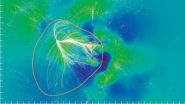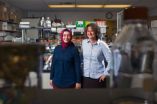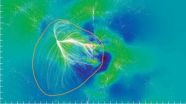(Press-News.org) University of Hawaii at Manoa astronomer R. Brent Tully, who recently shared the 2014 Gruber Cosmology Prize and the 2014 Victor Ambartsumian International Prize, has led an international team of astronomers in defining the contours of the immense supercluster of galaxies containing our own Milky Way. They have named the supercluster "Laniakea," meaning "immense heaven" in Hawaiian. The paper explaining this work is the cover story of the September 4 issue of the prestigious journal Nature.
Galaxies are not distributed randomly throughout the universe. Instead, they are found in groups, like our own Local Group, that contain dozens of galaxies, and in massive clusters containing hundreds of galaxies, all interconnected in a web of filaments in which galaxies are strung like pearls. Where these filaments intersect, we find huge structures, called "superclusters." These structures are interconnected, but they have poorly defined boundaries.
The researchers are proposing a new way to evaluate these large-scale structures by examining their impact on the motions of galaxies. A galaxy between two such structures will be caught in a gravitational tug-of-war in which the balance of the gravitational forces from the surrounding large-scale structures determines the galaxy's motion. By mapping the velocities of galaxies throughout our local universe, the team was able to define the region of space where each supercluster dominates.
The Milky Way resides in the outskirts of one such supercluster, whose extent has for the first time been carefully mapped using these new techniques. This Laniakea Supercluster is 500 million light-years in diameter and contains the mass of 1017 (a hundred quadrillion) sun in 100,000 galaxies.
This study clarifies the role of the Great Attractor, a problem that has kept astronomers busy for 30 years. Within the volume of the Laniakea Supercluster, motions are directed inwards, as water streams follow descending paths toward a valley. The Great Attractor region is a large flat bottom gravitational valley with a sphere of attraction that extends across the Laniakea Supercluster.
The name Laniakea was suggested by Nawa'a Napoleon, an associate professor of Hawaiian Language and chair of the Department of Languages, Linguistics, and Literature at Kapiolani Community College, a part of the University of Hawaii system.
The name honors Polynesian navigators who used knowledge of the heavens to voyage across the immensity of the Pacific Ocean.
INFORMATION:
The other authors are Hélène Courtois (University Claude Bernard Lyon 1, Lyon, France), Yehuda Hoffman (Racah Institute of Physics, Hebrew University, Jerusalem), and Daniel Pomarède (Institute of Research on Fundamental Laws of the Universe, CEA/Saclay, France).
A short video about Laniakea that gives the viewer a general sense of the structure of our home supercluster and of galaxy motions in the nearby universe is available at http://vimeo.com/104704518. A longer video that complements the Nature paper can be found at http://irfu.cea.fr/laniakea.
RESEARCHER CONTACT INFORMATION
Dr. Brent Tully
+1 808-956-8606
tully@ifa.hawaii.edu
ILLUSTRATION CAPTIONS
Figure 1: Two views of the Laniakea Supercluster. The outer surface shows the region dominated by Laniakea's gravity. The streamlines shown in black trace the paths along which galaxies flow as they are pulled closer inside the supercluster. Individual galaxies' colors distinguish major components within the Laniakea Supercluster: the historical Local Supercluster in green, the Great Attractor region in orange, the Pavo-Indus filament in purple, and structures including the Antlia Wall and Fornax-Eridanus cloud in magenta. Credit: SDvision interactive visualization software by DP at CEA/Saclay, France.
Figure 2: A slice of the Laniakea Supercluster in the supergalactic equatorial plane—an imaginary plane containing many of the most massive clusters in this structure. The colors represent density within this slice, with red for high densities and blue for voids—areas with relatively little matter. Individual galaxies are shown as white dots. Velocity flow streams within the region gravitationally dominated by Laniakea are shown in white, while dark blue flow lines are away from the Laniakea local basin of attraction. The orange contour encloses the outer limits of these streams, a diameter of about 160 Mpc. This region contains the mass of about 1017 suns: 100 million billion suns. Credit: SDvision interactive visualization software by DP at CEA/Saclay, France.
ABOUT IFA
Founded in 1967, the Institute for Astronomy at the University of Hawaii at Manoa conducts research into galaxies, cosmology, stars, planets, and the sun. Its faculty and staff are also involved in astronomy education, deep space missions, and in the development and management of the observatories on Haleakala and Maunakea. The Institute operates facilities on the islands of Oahu, Maui, and Hawaii.
Hawaii scientist maps, names Laniakea, our home supercluster of galaxies
2014-09-03
ELSE PRESS RELEASES FROM THIS DATE:
Sequencing of 5 African fishes reveals diverse molecular mechanisms underlying evolution
2014-09-03
Cambridge, MA. Wed. September 3, 2014 — In an effort to understand the molecular basis of adaptation in vertebrates, researchers sequenced the genomes and transcriptomes of five species of African cichlid fishes. A research team led by scientists at the Broad Institute of MIT and Harvard uncovered a variety of features in the cichlid genomes that enabled the fishes to thrive in new habitats and ecological niches within the Great Lakes of East Africa. In addition to helping explain the complex genomic mechanisms that give rise to incredible diversity among cichlid fishes, ...
Airlock-like transport protein structure discovered
2014-09-03
Palo Alto, CA—Sugars are an essential source of energy for microrganisms, animals and humans. They are produced by plants, which convert energy from sunlight into chemical energy in the form of sugars through photosynthesis.
These sugars are taken up into cells, no matter whether these are bacteria, yeast, human cells or plant cells, by proteins that create sugar-specific pores in the membrane that surrounds a cell. These transport proteins are thus essential in all organisms. It is not surprising that the transporters of humans and plants are very similar since they ...
Carbon stored in the world's soils more vulnerable to climate change than expected
2014-09-03
The response of soil microbial communities to changes in temperature increases the potential for more carbon dioxide to be released from the world's soils as global temperatures rise, scientists have revealed.
The potential for global warming to stimulate decomposition rates in soils, and thus release large quantities of carbon dioxide to the atmosphere, has long been considered to be one of the potentially most important positive feedbacks to climate change. However, the results from more recent studies have suggested that responses within microbial communities could ...
Study shows cellular RNA can template DNA repair in yeast
2014-09-03
The ability to accurately repair DNA damaged by spontaneous errors, oxidation or mutagens is crucial to the survival of cells. This repair is normally accomplished by using an identical or homologous intact sequence of DNA, but scientists have now shown that RNA produced within cells of a common budding yeast can serve as a template for repairing the most devastating DNA damage – a break in both strands of a DNA helix.
Earlier research had shown that synthetic RNA oligonucleotides introduced into cells could help repair DNA breaks, but the new study is believed to be ...
Newly identified galactic supercluster is home to the Milky Way
2014-09-03
Astronomers using the National Science Foundation's Green Bank Telescope (GBT) -- among other telescopes -- have determined that our own Milky Way galaxy is part of a newly identified ginormous supercluster of galaxies, which they have dubbed "Laniakea," which means "immense heaven" in Hawaiian.
This discovery clarifies the boundaries of our galactic neighborhood and establishes previously unrecognized linkages among various galaxy clusters in the local Universe.
"We have finally established the contours that define the supercluster of galaxies we can call home," said ...
Longitudinal study explores white matter damage, cognition after traumatic axonal injury
2014-09-03
Traumatic Axonal Injury is a form of traumatic brain injury that can have detrimental effects on the integrity of the brain's white matter and lead to cognitive impairments. A new study from the Center for BrainHealth at The University of Texas at Dallas investigated white matter damage in the acute and chronic stages of a traumatic axonal injury in an effort to better understand what long-term damage may result.
The study, published online July 21 in the Journal of Neurotrauma, looked at 13 patients ages 16 to 60 with mild to severe brain injuries from the intensive ...
Bariatric surgical center accreditation improves patient survival and postop complications
2014-09-03
CHICAGO (September 3, 2014): Patients who underwent weight loss operations in recent years, when most bariatric surgical centers were accredited, had fewer postoperative complications and were 2.3 times less likely to die in the hospital than patients who had bariatric procedures performed before a national movement toward facility accreditation was taking place, according to new study findings. Study authors, who published their results in the September issue of the Journal of the American College of Surgeons, say these findings suggest that accreditation of bariatric ...
Is a gluten-free diet enough to control the complications of celiac disease?
2014-09-03
New Rochelle, NY, September 2, 2014—A lifelong gluten-free diet (GFD) is the conventional approach to managing celiac disease, a chronic inflammatory disorder affecting the small intestine that can result in malnutrition. However, recent evidence shows that a GFD may not be sufficient to prevent serious complications related to celiac disease. A detailed discussion of the metabolic disorders and functional abnormalities that can develop, and nutritional treatments for these is presented in a Review article published in Journal of Medicinal Food, a peer-reviewed journal ...
Innovative algorithm spots interactions lethal to cancer
2014-09-03
Despite the revolutionary biotechnological advancements of the last few decades, an ideal anti-cancer treatment — one that's immediately lethal to cancer cells, harmless to healthy cells, and resistant to cancer's relapse — is still a dream.
But a concept called "synthetic lethality" holds great promise for researchers. Two genes are considered synthetically lethal when their combined inactivation is lethal to cells, while inhibiting just one of them is not. Synthetic lethality promises to deliver personalized, more effective, and less toxic therapy. If a particular gene ...
Transplanted stem cells help prevent bladder fibrosis after spinal cord injury
2014-09-03
Putnam Valley, NY. (Sept. 3, 2014) – A team of researchers from Korea and Canada have found that transplantation of B10 cells (a stable immortalized human bone marrow derived –mesenchymal stem cell line; B10 hMSC) directly into the bladder wall of mice modeled with spinal cord injury (SCI) helped inhibit the development of bladder fibrosis and improved bladder function by promoting the growth of smooth muscle cells in the bladder.
The study will be published in a future issue of Cell Transplantation and is currently freely available on-line as an unedited early e-pub ...





